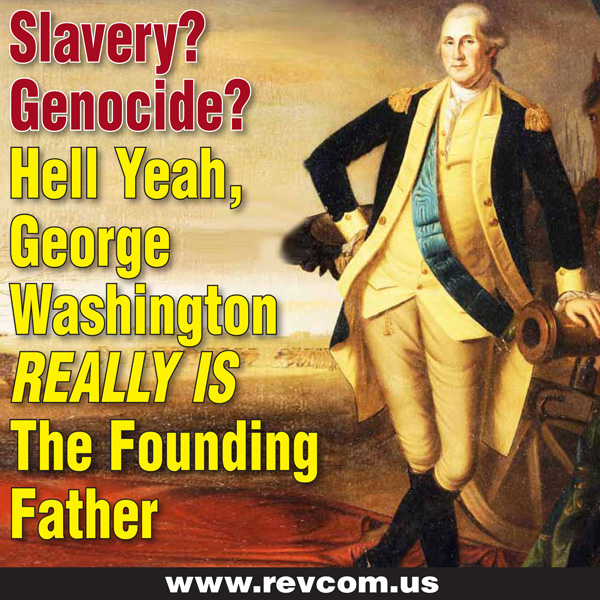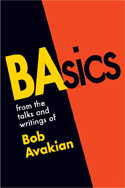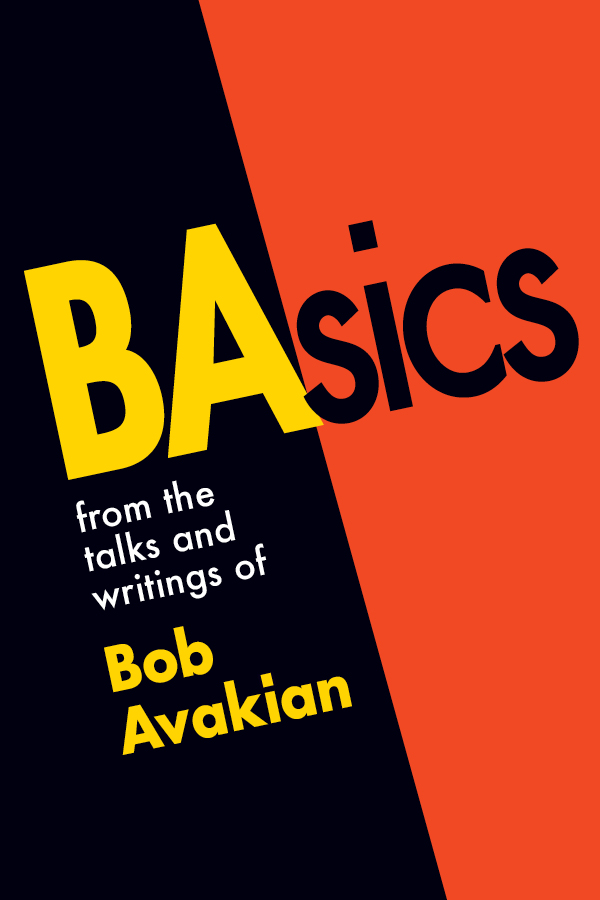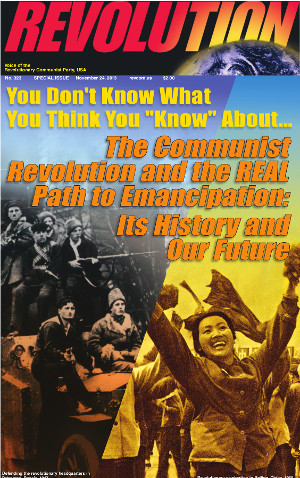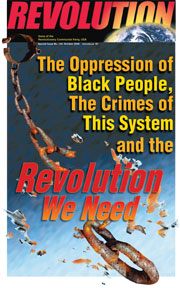Case #90: The Sullivan Expedition, 1779—Genocide of Native Peoples and Scorched Earth in Upstate New York
July 4, 2016 | Revolution Newspaper | revcom.us
Bob Avakian recently wrote that one of three things that has “to happen in order for there to be real and lasting change for the better: People have to fully confront the actual history of this country and its role in the world up to today, and the terrible consequences of this.” (See “3 Things that have to happen in order for there to be real and lasting change for the better.”)
In that light, and in that spirit, “American Crime” is a regular feature of revcom.us. Each installment will focus on one of the 100 worst crimes committed by the U.S. rulers—out of countless bloody crimes they have carried out against people around the world, from the founding of the U.S. to the present day.
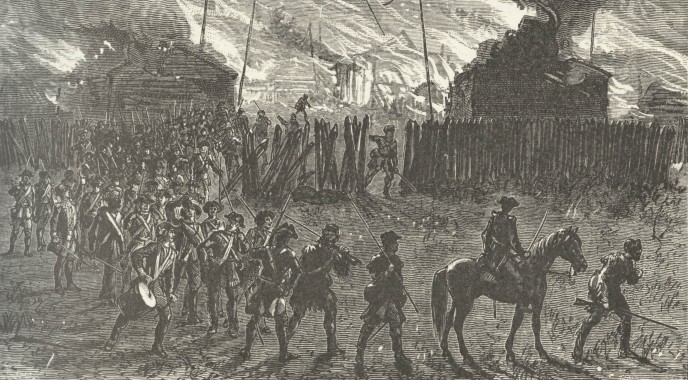
Destruction of Indian villages
The Crime
In June 1779, heavily armed caravans of more than 6,200 American soldiers headed north from Pennsylvania and west from a town near Albany, New York. These forces, under the command of General John Sullivan, comprised about 25 percent of the Continental Army, which had been formed by the Continental Congress of former colonies that were in a war for independence from England.
Their target: Native American tribes who lived in western New York—the Mohawk, Oneida, Onondaga, Tuscarora, Cayuga, and Seneca peoples. These peoples called themselves the Haudenosaunee, and are known to historians as the Iroquois League or Iroquois Confederacy. The mission of Sullivan’s troops: the “total destruction and devastation of their settlements, and the capture of as many prisoners of every age and sex as possible,” in the words of the commander in chief of the Continental Army.
For the next three months, Sullivan’s troops marched across western New York in a scorched-earth campaign. They destroyed everything they came across. The Iroquois had been living in this area for hundreds of years and had highly developed agriculture and well-established villages. Many of the invaders expressed envy at the abundance of the people whose lives they destroyed and at the sturdiness of their homes.
One historian described how Sullivan’s troops “methodically looted and destroyed every Iroquois town and village on their route into Finger Lakes country, their progress marked by smoldering villages and blackened fields.” By the end of September, the American forces had demolished “roughly 50 towns, 1 million bushels of corn, 50 thousand bushels of vegetables, and 10 thousand fruit trees.”
Most of the people were able to flee in the face of the advancing juggernaut, and the number of Native Americans killed by the soldiers is unknown. But those 5,000 residents who were able to survive by fleeing were now turned into refugees, and the great tribes were broken.
Men, women, and children captured by the advancing Americans were held in prisons for years after the onslaught, and many died as prisoners. Thousands of people who survived were forced to flee towards British-held areas in Canada during the dangerously cold winter months with heavy snowfall. During what became known as the “Winter of Hunger,” entire families froze to death. Hundreds of people died from malnutrition and disease. The dead were buried in mass graves. Years later, a white woman who had lived with the Seneca spoke of the indescribable trauma: “What were our feelings? When we found that there was not a mouthful enough to keep a child from perishing with hunger?”
The Criminals
The commander in chief who ordered and oversaw this massive crime was George Washington—the “father of our country” to those who uphold America and all that it stands for. Washington was known to the Iroquois as “Conotocarious”—the “devourer of villages.” Washington’s first military experience was as a British officer in the French and Indian War (1754-63), when his orders were to imprison or kill and destroy all who resisted or opposed his army. He commanded his generals and troops to apply this policy of “kill all” Native Americans during the war of independence against England.
General John Sullivan, who followed Washington’s command and carried out the genocidal campaign of mass destruction and slaughter. Countless genocidal atrocities had been committed against Native peoples since European colonists first arrived in North America. What sets the Sullivan Expedition apart is that it was the first time the forerunner of the U.S. Army carried out an official genocidal campaign against Native peoples. It would be repeated many times over.
The Alibi
George Washington and other American leaders claimed they were acting to defend themselves. They claimed that the atrocities and the mass destruction they unleashed were in response to attacks on farming villages from some of the Iroquois tribes, in conjunction with British troops with whom the colonists were at war.
The Actual Motive
Even as the leaders of the former colonies that would become the United States were fighting for political independence from England, they were also fighting to open up westward expansion of the country into territories where Native Americans had been living for centuries. One area over which they sought to gain control was upstate and western New York, which was seen as a link to the Great Lakes region. Vanquishing and destroying the Iroquois who lived in this region was key to achieving their goal.
The United States claimed that its victory over the British meant a victory over Native Americans as well. The remnants of the peoples who had lived in this area of New York were officially dispossessed by the Treaty of Paris that affirmed the U.S. triumph over England in its war of independence. Then, in 1788, the Fort Stanwix Treaty ended any Native claims to the land. Huge tracts of land that the Iroquois had lived on and worked for hundreds of years were given to the soldiers who had burned and murdered their way across the state.
A history of upstate New York recorded: “In 1789, the Indian titles to most of the lands in the State of New York, having been extinguished, the Legislature provided for the survey of a certain portion of these lands, already set apart for the soldiers of the State, who had served in the war of the Revolution. This tract embracing 1,680,000 acres, and denominated the Military Tract ... containing each one hundred lots of six hundred acres. Each private soldier and non-commissioned officer had one lot assigned him. The officers received larger shares in proportion to their rank.”
The genocide and dispossession of the Iroquois in upstate New York provided a model for how the U.S. committed genocide against Native Americans and seized their land across the entire country as it expanded westward. Washington, a Virginia slaveowner who had also surveyed and purchased land occupied by Native Americans in what became the state of Ohio, himself bought 6,100 acres of fertile land near what is now the city of Utica, New York. White Americans flooded the area, and the fact that Native peoples had once been its occupants was recognized only in some of the place names such as Cayuga, Seneca, and Oneida.
Repeat Offenders
With the formation of the United States, genocidal atrocities against Native Americans became official political and military policy. The Trail of Tears... the “Cherokee Removal”... the Seminole Wars... the “Dakota War” in Minnesota... the depredations against the Apaches, Comanches, and other peoples of what is now the U.S. Southwest... The list of horrors is endless. Entire peoples, languages, and cultures have been obliterated by brute force. The theft of the lands those people occupied has been enshrined in U.S. law, over and over and over again. (Revolution will further expose this in the American Crime series.)
These crimes continue to this day—through the high incidence of murder and brutality by police against Native Americans, the continued degradation and ridicule inflicted on their cultures, the extreme poverty and desperation in the concentration camps (aka “reservations”) on which many are forced to live, and other measures.
Volunteers Needed... for revcom.us and Revolution
If you like this article, subscribe, donate to and sustain Revolution newspaper.


